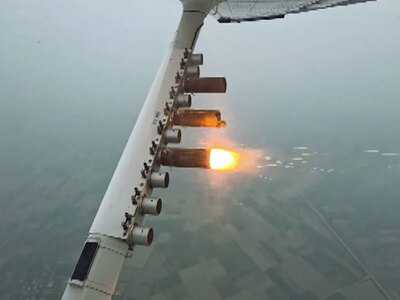New Delhi [India], October 29 (ANI): The Delhi Government completed two consecutive cloud seeding operations as part of its robust air quality management strategy.
Delhi Environment Minister Manjinder Singh Sirsa said that with this move, the national capital has taken an unprecedented, science-first step by adopting cloud seeding as a tool to control air pollution. "Our focus is to assess how much rainfall can be triggered under Delhi's real-life humidity conditions. With every trial, science guides our actions--for the winter and all year round."
As per a press note, both sorties were managed by IIT Kanpur's expert team, launched from IIT Kanpur and Meerut airfields and covered Khekra, Burari, North Karol Bagh, Mayur Vihar, Sadakpur, Bhojpur, and surrounding sectors. Each flare weighed about 0.5 kg, with eight flares released per sortie, dispersing a tested mixture designed to enhance precipitation potential. Reported humidity levels in seeded clouds ranged from 15-20%--lower than ideal, but sufficient for a scientifically meaningful test.
The operation lasted about one and a half hours for each sortie, ensuring consistent coverage. Minister Sirsa emphasised, "According to expert forecasts, rain after seeding could occur anytime in the next 24 hours, depending on cloud moisture. Initial weather radar readings and on-ground observations recorded light rainfall of 0.1-0.2 mm at Delhi-Noida Border around 4 PM, indicating some positive response from the seeded clouds."
The preliminary results suggested that data from 20 selected monitoring sites across Delhi were captured, with a primary focus on AQI, PM2.5 and PM10, the most direct pollution markers.
Before the first seeding: PM2.5 at Mayur Vihar, Karol Bagh, and Burari was 221, 230, and 229 ug/m³, which fell to 207, 206, and 203 ug/m³ respectively after the operation, press noted stated.
PM10 at the same sites dropped from 207, 206, and 209 ug/m³ to 177, 163, and 177 ug/m³ post-seeding, it added.
With minimal winds reported, this reduction is attributed mainly to the added cloud moisture and particle settling caused by the cloud seeding particles.
Sirsa said that depending on the results, the government is prepared for further cloud seeding sorties in the coming weeks and after the first round of trials. "The results will determine whether we should plan more seeding experiments till February."
Cloud seeding is an advanced weather modification science, intended to trigger or enhance rainfall from suitable clouds by introducing selected particles--such as silver iodide or sodium chloride--using aircraft or other means. (ANI)
You may also like

"BJP wants to drive Muslims out of India, have problem with person becoming Deputy CM from backward community": VIP chief Mukesh Sahani

President Murmu to take sortie in Rafale fighter jet at Ambala Air Force Station today

Get £210 cut off Nintendo Switch price with simple shopping tip

Smart Skincare Devices of 2025: The Future of At-Home Beauty

PM Modi to address Maritime Leaders Conclave in Mumbai today







